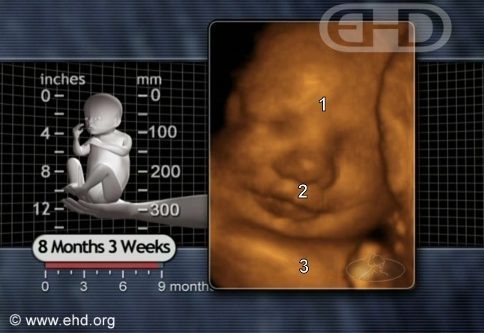A new study from the University of Kansas (KU) shows that preborn babies can actually distinguish between languages while in the womb. Published in NeuroReport, the study is summarized in layman’s terms by Science Daily:
A month before they are born, fetuses carried by American mothers-to-be can distinguish between someone speaking to them in English and Japanese. Using non-invasive sensing technology for the first time for this purpose, a group of researchers has shown this in-utero language discrimination. Their study has implications for fetal research in other fields.
The study was conducted with 24 pregnant women with a mean gestational age of 35.5 weeks.
The Mayo Clinic reports that at week 18 in utero, “your baby might begin to hear.” The KU study seems to support this possibility. According to Science Daily, “English and Japanese are argued to be rhythmically distinctive. English speech has a dynamic rhythmic structure resembling Morse code signals, while Japanese has a more regular-paced rhythmic structure.” The researchers, led by Utako Minai, associate professor of linguistics at KU, knew that other studies of babies a few days old showed they might distinguish languages, so they wondered if this distinction happened in utero. Minai said:
This early discrimination led us to wonder when children’s sensitivity to the rhythmic properties of language emerges, including whether it may in fact emerge before birth. Fetuses can hear things, including speech, in the womb. It’s muffled, like the adults talking in a “Peanuts” cartoon, but the rhythm of the language should be preserved and available for the fetus to hear, even though the speech is muffled.
The researchers used a magnetocardiogram (MCG) available at KU Medical Center’s Hoglund Brain Imaging Center, which has one of the two available MCGs in the United States. Kathleen Gustafson, a faculty member in the Department of Neurology, who was part of the research team, explains that the MCG “fits over the maternal abdomen and detects tiny magnetic fields that surround electrical currents from the maternal and fetal bodies.” Gustafson adds:
The biomagnetometer is more sensitive than ultrasound to the beat-to-beat changes in heart rate,” she said. “Obviously, the heart doesn’t hear, so if the baby responds to the language change by altering heart rate, the response would be directed by the brain.
The researchers found that the babies did, indeed, show a heart rate change, showing that some of their development is connected with language, as Gustafson notes:
The fetal brain is developing rapidly and forming networks. The intrauterine environment is a noisy place. The fetus is exposed to maternal gut sounds, her heartbeats and voice, as well as external sounds. Without exposure to sound, the auditory cortex wouldn’t get enough stimulation to develop properly.
Minai and other researchers simply had a person fluent in both Japanese and English record two recordings, one in each language, which were, in turn, played for the baby. The results were clear, showing a changed heart rate when the babies heard “unfamiliar, rhythmically distinct” Japanese immediately after hearing the English recording. However, a second recording of English did not change the babies’ heart rates.
The results came out nicely, with strong statistical support. These results suggest that language development may indeed start in utero. Fetuses are tuning their ears to the language they are going to acquire even before they are born, based on the speech signals available to them in utero. Pre-natal sensitivity to the rhythmic properties of language may provide children with one of the very first building blocks in acquiring language.
While researchers are touting the implications of this study on other research or in other fields, the implication of this research on the pro-life movement is obvious and notable. In several states, a 35.5 week old preborn baby can be legally aborted. Yet this study shows that the child can hear well enough to distinguish languages. How much more alive can that baby be? It is illegal to kill an innocent person in the United States. The definition of what makes a person may be argued among abortion advocates, but no one would argue that it was a “clump of cells” that heard language variations and responded to them with different heart rates. Clearly, even these researchers who worked on a linguistic study are also proving life within the womb is, indeed, a very real human life.
This knowledge may lead more individuals to the horrific realization that abortion is taking the life of a person, who not only has a heartbeat, but who also has cognitive abilities to hear and understand language variations.
This knowledge might also cause a revisit of Roe v. Wade at the Supreme Court to result in a striking down of the old law. In 1973, there was little technology to prove the reality of the unique living and thinking individual in the womb. But as yet another study — of myriads of studies — has shown, there is no doubt that the preborn child in the womb is more human than any pro-abortion apologist would care to admit.








